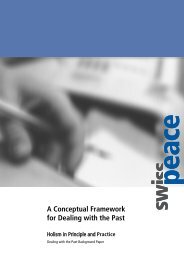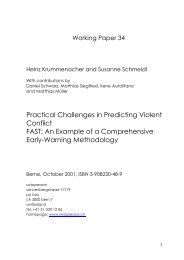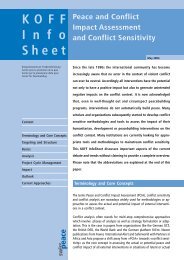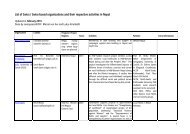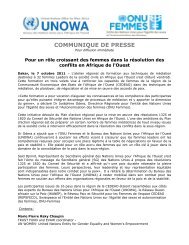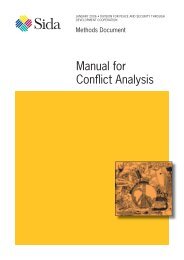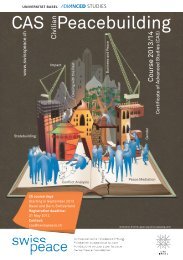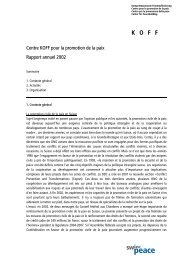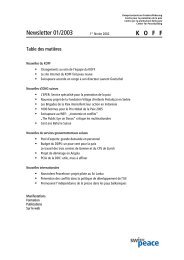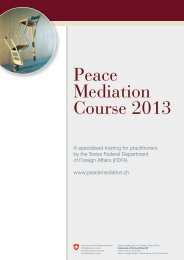Unpacking the Mystery of Mediation in African Peace ... - Swisspeace
Unpacking the Mystery of Mediation in African Peace ... - Swisspeace
Unpacking the Mystery of Mediation in African Peace ... - Swisspeace
You also want an ePaper? Increase the reach of your titles
YUMPU automatically turns print PDFs into web optimized ePapers that Google loves.
Burundi, Arusha <strong>Peace</strong> Process<br />
Burundi, Arusha <strong>Peace</strong> Process<br />
By Simon J A Mason, <strong>Mediation</strong> Support Project, Center for Security Studies, ETH Zurich<br />
In a Nutshell<br />
Political manipulation <strong>of</strong> ethnic and class differences<br />
goes back to pre-<strong>in</strong>dependence <strong>of</strong> Burundi<br />
<strong>in</strong> 1962. In 1993, Melchior Ndadaye, <strong>the</strong> very<br />
first Hutu president ever elected, was assass<strong>in</strong>ated,<br />
launch<strong>in</strong>g <strong>the</strong> country once aga<strong>in</strong> <strong>in</strong>to crisis.<br />
Some 250,000 people were killed between 1993<br />
and 2003. Hutu upris<strong>in</strong>gs were followed by repression<br />
from <strong>the</strong> side <strong>of</strong> <strong>the</strong> Tutsi-dom<strong>in</strong>ated<br />
army. Serious efforts to mediate <strong>the</strong> Burundi crisis<br />
began <strong>in</strong> 1996, with regional states impos<strong>in</strong>g<br />
sanctions on Burundi. The Arusha talks were first<br />
led by <strong>the</strong> chief mediator Julius Nyerere and later<br />
by Nelson Mandela. 19 parties signed <strong>the</strong> “Arusha<br />
<strong>Peace</strong> and Reconciliation Agreement for Burundi”<br />
<strong>in</strong> 2000, creat<strong>in</strong>g <strong>in</strong>stitutions for transition<br />
to democracy, power-shar<strong>in</strong>g, and security<br />
sector reform. Political parties and some <strong>of</strong> <strong>the</strong><br />
armed groups participated <strong>in</strong> <strong>the</strong> Arusha process.<br />
However, some <strong>of</strong> <strong>the</strong> armed spl<strong>in</strong>ter groups cont<strong>in</strong>ued<br />
fight<strong>in</strong>g <strong>in</strong> <strong>the</strong> hills, so that ceasefires with<br />
<strong>the</strong>se armed groups had to be negotiated after <strong>the</strong><br />
peace agreement (various ceasefires were signed<br />
between 2003 and 2008). The Arusha Accords<br />
were more successful than expected, key challenges<br />
rema<strong>in</strong> with regard to <strong>the</strong> def<strong>in</strong>itive settlement<br />
<strong>of</strong> <strong>the</strong> armed conflict with <strong>the</strong> rema<strong>in</strong><strong>in</strong>g<br />
armed group Palipehutu-FNL.<br />
Key Messages<br />
Regional mediation effort: The Arusha process was<br />
a regional process, with less <strong>in</strong>fluence from outside<br />
<strong>the</strong> cont<strong>in</strong>ent than some more recent peace<br />
processes <strong>in</strong> Africa. The decision <strong>of</strong> <strong>the</strong> heads <strong>of</strong><br />
states <strong>of</strong> <strong>the</strong> regional countries to impose sanctions<br />
<strong>in</strong> 1996, follow<strong>in</strong>g Pierre Buyoya’s coup,<br />
was a fundamental shift <strong>in</strong> <strong>in</strong>ter-<strong>African</strong> relations.<br />
Outspoken role <strong>of</strong> facilitator: Both Julius Nyerere<br />
and later Nelson Mandela greatly shaped <strong>the</strong><br />
process by <strong>the</strong>ir personality. Unlike <strong>the</strong> Western<br />
notion <strong>of</strong> a “neutral” mediator, Nelson Mandela<br />
showed how <strong>the</strong> role <strong>of</strong> a moral chief mediator, or<br />
“facilitator” as he called himself, can be under-<br />
taken <strong>in</strong> a very outspoken manner. He worked for<br />
mutually acceptable solutions, but at <strong>the</strong> same<br />
time he was openly critical <strong>of</strong> <strong>the</strong> government<br />
(e.g., about how <strong>the</strong>y held political prisoners),<br />
and he compared <strong>the</strong> IDP camps to concentration<br />
camps. This form <strong>of</strong> “moral pressure” cannot<br />
be exerted by anyone, but when exercised by<br />
Mandela, with his personal reputation as <strong>the</strong> “Fa<strong>the</strong>r<br />
<strong>of</strong> Africa”, it was effective.<br />
Participation: The Arusha talks <strong>in</strong>cluded all political<br />
parties, and some, but not all, <strong>of</strong> <strong>the</strong> armed<br />
groups. The number <strong>of</strong> parties grew from 17 to<br />
19 towards <strong>the</strong> end <strong>of</strong> <strong>the</strong> process, <strong>the</strong>reby be<strong>in</strong>g<br />
an example <strong>of</strong> a ra<strong>the</strong>r <strong>in</strong>clusive process. Never<strong>the</strong>less,<br />
some spl<strong>in</strong>ter armed groups did not sign,<br />
and called for separate ceasefire agreements later<br />
on.<br />
Use <strong>of</strong> sufficient consensus: All important parties<br />
must be <strong>in</strong>cluded and engaged <strong>in</strong> successful political<br />
negotiations. However, <strong>the</strong> more parties are<br />
<strong>in</strong>volved, <strong>the</strong> more difficult and complex <strong>the</strong><br />
talks. There is also a danger that parties are<br />
formed <strong>in</strong> order to enhance <strong>the</strong> weight <strong>of</strong> one’s<br />
position at <strong>the</strong> table (or to get paid for attend<strong>in</strong>g).<br />
One way <strong>of</strong> deal<strong>in</strong>g with this, and that began to<br />
take effect towards <strong>the</strong> end <strong>of</strong> <strong>the</strong> Arusha talks, is<br />
<strong>the</strong> use <strong>of</strong> “sufficient consensus”, where <strong>the</strong> mediators<br />
work towards a consensus between <strong>the</strong><br />
large parties, and <strong>the</strong>se <strong>the</strong>n try to pull <strong>the</strong> smaller<br />
parties along with <strong>the</strong>ir decision.<br />
Use <strong>of</strong> a draft to overcome deadlock: It is always a<br />
delicate matter when mediators propose a draft,<br />
as it is probable that <strong>the</strong>y will be seen as be<strong>in</strong>g biased.<br />
However, <strong>the</strong>re are times when talks do not<br />
move ahead, and <strong>the</strong> presentation <strong>of</strong> a draft can<br />
help to overcome deadlock. In <strong>the</strong> Arusha negotiations<br />
this was successful, but <strong>the</strong> parties also<br />
had ample time to adapt <strong>the</strong> draft.<br />
21




